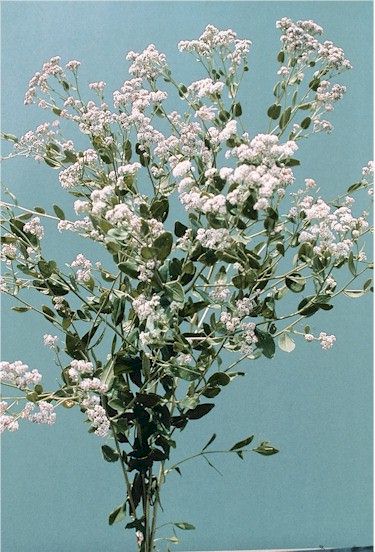|
Description:
Perennial pepperweed is a hardy perennial plant
that can reach 6 feet in height under ideal
conditions. It reproduces by seeds and from a
deep, creeping root system. Basal leaves are
waxy and lance-shaped on a long petiole. Stem
leaves are smaller with short stalks. Leaves
have a prominent white mid-vein. The tiny
flowers have four white petals and are arranged
in numerous rounded clusters on the ends of the
branches. Each flat, elongated capsule produces
two seeds.
|
 |
|
Management
Guidelines:
Type and Class of
Livestock:
All classes of sheep and goats.
Grazing Objective:
Remove 85% of top growth with repeated grazing
treatments (every three to four weeks) to remove
regrowth.
Growth Stage for
Treatment:
Sheep and goats will readily consume the plants
until the early flowering stage, with preference
for early vegetative stages. Repeated grazing
for several years will be necessary to suppress
perennial pepperweed long term.
Potential Effectiveness:
Repeated, intensive grazing can significantly
reduce perennial pepperweed biomass, density,
and height in a single season, but the massive
root system rapidly replenishes the infestation.
Thus, grazing must be continued for several
years to deplete root reserves. Results vary as
to the long-term impacts of targeted grazing for
plant suppression. Grazing can be combined with
other herbicide spraying for long-term perennial
pepperweed management. |
|
References:
Allen, J.R., D.W. Holcombe, D.R. Hanks, M.
Surian, M. McFarland, L.B. Bruce, and W.
Johnson. 2001. Effects of sheep grazing and
mowing on the control or containment of tall
whitetop. Proceedings of the Western Section
American Society of Animal Science 52:77
(Abstract).
Carpinelli,
M.F., C.S. Schauer, D.W. Bohnert, S.P.
Hardegree, S.J. Falck and T.J. Svejcar.
2004. Effect of
ruminal incubation on perennial pepperweed
germination. Rangeland Ecology and Management
58:632-636.
Clements, C. D., J.
A. Young. 2006. The use of goat grazing to
biologically suppress perennial pepperweed
Available at: http://www.ars.usda.gov/research/publications/Publications.htm?seq_no_115=183198
Assessed 14 August 2006.
Renz, M.J. 2000. Lepidium latifolium L.
In: J.M.Randall [Ed.] Element stewardship
abstracts. The Nature Conservancy, Arlington,
Virginia. Available at:
http://tncweeds.ucdavis.edu/esadocs/lepilati.html
Accessed 03 September 2006
Ryan, M., S. Donaldson, and W. Johnson. 2002.
Perennial pepperweed (Lepidium latifolium)
in Southern Nevada. University of Nevada, Reno.
Cooperative Extension.
FS-02-98 Available at:
http://www.unce.unr.edu/publications/FS02/FS0298.pdf.
Accessed 03 September 2006. |
![]()